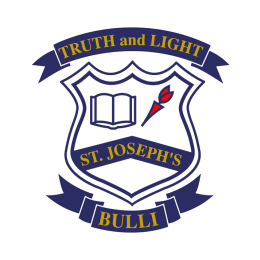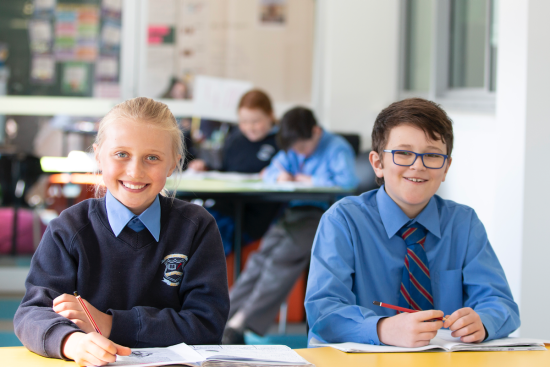
St Joseph's
Bulli
Bulli
A Catholic Parish Primary School
 St Joseph's Catholic Primary School, Bulli is registered by the NSW Education Standards Authority (NESA) and is subject to its curriculum requirements of the NSW Education Act.
St Joseph's Catholic Primary School, Bulli is registered by the NSW Education Standards Authority (NESA) and is subject to its curriculum requirements of the NSW Education Act.
Requirements include an educational program based on, and taught in accordance with, the outcomes of NESA syllabuses in the six Key Learning Areas (KLAs) of English, Mathematics, Science & Technology, Human Society and its Environment, Creative Arts, and Personal Development, Health and Physical Education.
In addition, a KLA in Religious Education is taught in theory and practice.
Through the study of English students learn about the power, value and art of the English language for communication, learning and enjoyment.
Developing proficiency in English enables students to become confident communicators, critical and imaginative thinkers and lifelong learners. Students develop their language skills through activities involving speaking and listening, reading and writing, and viewing and representing. They learn about language and literature through working with a wide range of print, spoken, visual, media, multimedia and digital texts.
In each Year students must study examples of:
Objectives: through responding to and composing a wide range of texts and through the close study of texts, students will develop knowledge, understanding and skills in order to:
The content includes the areas of:
The aim of Mathematics is for students to:
Knowledge, skills and understanding
Students:
Working Mathematically
Number and Algebra
Measurement and Geometry
Statistics and Probability
Students:
Through studying Science and Technology students explore scientific and technological concepts and gain knowledge and understanding of the world. They develop skills in conducting scientific investigations and designing and producing solutions through learning about the Living World, Material World, Physical World, Earth and Space, and Digital Technologies. (NESA)
The Science and Technology K–6 syllabus content is organised into Stages from Early Stage 1 to Stage 3. The outcomes are presented as:
The knowledge and understanding in Science and Technology K–6 are developed through the skills of Working Scientifically, and Design and Production. By the end of each Stage, students will have had opportunities to investigate scientifically and apply their knowledge and understanding in the creation of designed solutions.
The five content strands in Science and Technology K–6 are the basis for the continuum of learning for both Science Years 7–10 and Technology Mandatory Years 7–8. All five content strands are to be delivered by the end of each Stage.
The five content strands are:
Human Society and Its Environment (HSIE) is the study of how humans interact with the world, how society operates and how it is changing. Through the study of HSIE, students develop the skills to prepare them to actively and responsibly participate as informed citizens in the contemporary world.
The aim of Geography in Years K–10 is to stimulate students’ interest in and engagement with the world. Through geographical inquiry they develop an understanding of the interactions between people, places and environments across a range of scales in order to become informed, responsible and active citizens.
Knowledge and understanding
Students:
Skills
Students:
Values and attitudes
Students will value and appreciate:
The aim of the History syllabus is to stimulate students’ interest in and enjoyment of exploring the past, to develop a critical understanding of the past and its impact on the present, to develop the critical skills of historical inquiry and to enable students to participate as active, informed and responsible citizens.
Knowledge, understanding and skills
Early Stage 1 – Stage 3
Students:
Values and attitudes K–10
Students will value and appreciate:
The school’s Personal Development, Health and Physical Education (PDHPE) program aims to develop in each student the knowledge, skills and attitudes needed to understand, value and lead healthy and fulfilling lives.
The three strands of PDHPE are:
There are eight content strands:
As part of maintaining a healthy and balanced lifestyle our school participates in ‘Crunch and Sip’. This involves eating fresh vegetables and fruit during the morning session to form positive eating habits and aide in sustaining concentration and energy levels in students.
In addition to the PDHPE Syllabus requirements, other sporting opportunities are available for students. Read more about the Sporting Opportunities available to our students.
Creative Arts enables students to gain increasing understanding and accomplishment in:
Students are able to appreciate the meanings and values that each of the art forms offer personally, culturally and as forms of communication.
The primary (K-6) curriculum is organised into stages:
|
Early Stage 1 |
Kindergarten |
|
Stage 1 |
Year 1 and Year 2 |
|
Stage 2 |
Year 3 and Year 4 |
|
Stage 3 |
Year 5 and Year 6 |
Most students will be working towards the outcomes for their Stage.
For more information on the NSW curriculum, visit the NESA website.
Student progress is formally reported to parents with mid-year and end of year reports. These reports also use the A-E Common Grade Scale to indicate the extent to which students have demonstrated the achievement of the outcomes, with a ‘C’ grade indicating that the student is demonstrating achievement of the outcomes. Read more about our Assessment and Reporting.
Parents are partners with the school staff in the education of their children and are welcome to make appointments to speak with teachers about their child.
Did You Know: St Joseph's is committed to working in partnership with families and community in welcoming Aboriginal and Torres Strait Islander students – supporting them to reach their full potential and to embrace their culture and identity. Read more here